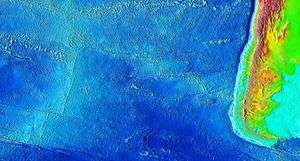Farellones Formation
| Farellones Formation Stratigraphic range: Miocene | |
|---|---|
| Sub-units |
Upper member Lower member |
| Overlies | Abanico Formation |
| Thickness | >3,000 m |
| Lithology | |
| Primary | Rhyolitic ignimbrite, rhyolitic tuff, andesitic lava, basaltic lava |
| Other | Breccia |
| Location | |
| Region |
Valparaíso Region Santiago Metropolitan Region O'Higgins Region |
| Country | Chile |
| Type section | |
| Named for | Farellones |
| Named by | Carlos Klohn (1960) |
Farellones Formation (Spanish: Formación Farellones) is a geological formation of Miocene age in the Andes of Central Chile up almost entirely of volcanic and volcaniclastic rocks. At some location reaches thicknesses in excess of 3,000 m.[1] It overlies the Oligo–Miocene Abanico Formation across a diachronous unconformity.[1] The best exposure of the formation is said to be at the ski resort of Farellones east of Santiago.[2] From the latitude of Santiago to Rancagua the base of the formation becomes progressively younger and outcrops more scarce.[1][2] In the mentioned latitudes the formation has been deformed by a diachronous tectonic inversion that produced reverse faults and destroyed the extensional sedimentary basin were the rocks deposited and contributed to the uplift of the Andes in the Late Miocene.[1]
Rivano and co-workers define two sub-units of the formation: a lower member made up of rather fresh rhyolitic ignimbrite and tuff, and an upper member made up of lavas of basaltic and andesitic composition.[3] The volcanic rocks of Farellones Formation have mostly a calc-alkaline character contrasting with the mostly tholeiitic Abanico Formation.[1]
Jorge Muñoz Cristi was in 1957 the first to define the rocks of Farellones as distinct unit and not as a facies as previously thought. Carlos Klohn then established the Farellones unit as formation in 1960.[3]
References
- 1 2 3 4 5 Godoy, Estanislao (2012). "Sobre el variable marco geotectónico de las formarciones Abanico y Farellones y sus equivalentes al ser de los 35°LS". Revista de la Asociación Geológica Argentina (in Spanish). 69 (4): 570–577. Retrieved 30 December 2015.
- 1 2 Vergara, Mario; Drake, Robert (1979). "Edades K/ar en secuencias volcánicas continentales postneocomianas de Chile Central; su depositación en cuencas intermontanas restringidas". Revista de la Asociación Geológica Argentina (in Spanish). XXXIV (1): 42–52.
- 1 2 Rivano, Sergio; Godoy, Estanislao; Vergara, Mario; Villarroel, Renato (1990). "Redefinición de la formación Farellones en los Andes de Chile Central (32-34°S)". Revista Geológica de Chile (in Spanish). 17 (2): 205–214.
- "Edades K/ar de la formación Farellones en el cordón del Cerro La Parva, Cordillera de los Andes de Santiago, Chile" (in Spanish). 1986.
